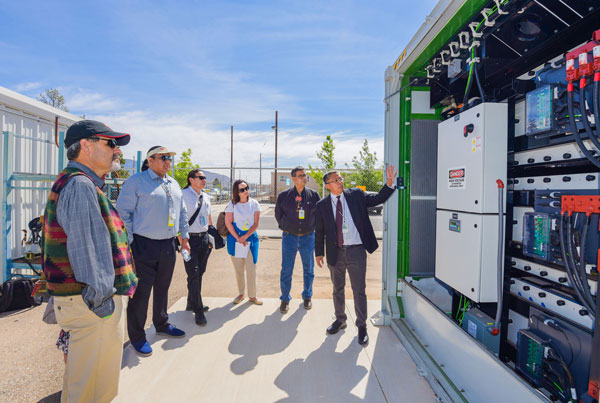Meeting discusses the state of STEM education, employment in Indian country
Sandia recently hosted visitors from the DOE Indian Country Energy and Infrastructure Working Group and informed ICEIWG members, DOE officials and intergovernmental and contracted partners about Sandia’s unique role in energy research.
The ICEIWG is comprised of DOE representatives, tribal leaders and their technical staffs who identify opportunities and obstacles to building energy capacity and related infrastructure development in Indian country.
Attendees Kevin Frost, DOE deputy director, Office of Indian Energy Policy & Programs and Doug Little, deputy assistant secretary, Intergovernmental and External Affairs, joined Sandra Begay, Sandia’s Indian Energy program lead, who updated the tour participants on the state of STEM education in Indian Country.
“Indian Country faces many challenges in developing energy infrastructure and the advanced technical workforce required to support such infrastructure,” says Sandra.
American Indians/Alaska Native students have the lowest overall graduation rate among any minority group. Only a small percentage of kindergarten students will go on to earn a bachelor’s degree.
American Indians/Alaska Natives are also under-represented in science and engineering at the bachelor’s, master’s and doctoral levels. Fewer than half attend a public high school where the full range of mathematics and science courses are offered. Although they make up 1.2 percent of the U.S. population, they represent only 0.4 percent of all engineering bachelor’s degree recipients, 0.3 percent of the engineering workforce (just 0.07 percent of those are women) and 0.1 percent of all engineering faculty.
Energy researcher Sig Gonzalez led tour members though Sandia’s Distributed Energy Technology Lab, describing Sandia’s work on utility-scale battery challenges and on standalone residential devices.
Systems engineer Bruce King discussed solar energy and grid integration work at Sandia’s Photovoltaic Systems Evaluation Lab and the work Sandia does as the lead on DOE’s Regional Test Center Program.
Optical engineer Julius Yellowhair led visitors through Sandia’s National Solar Thermal Testing Facility and discussed Sandia’s ongoing falling particle receiver research, part of Sandia’s proposed design for a high temperature concentrating solar power pilot plant.

Managers Abraham Ellis and Lori Parrott shared an overview of Sandia’s Alaska research, including work supporting Alaskan resilience against natural disasters and the harsh environment. Sandia also studies the suitability of renewable energy and microgrids for the Arctic environment, flies tethered balloons and drones to measure atmospheric temperatures and collaborates with other researchers on satellite sensing, detection and nonproliferation work.
Power electronics researcher Stan Atcitty led visitors through Sandia’s energy test facilities, including the Energy Storage Analysis Laboratory and the Energy Storage Test Pad/Energy Storage Analysis Lab.
Stan says Sandia’s work also is funded by the NNSA’s Minority Serving Institute Partnership Program, which pays for a three-year project to enhance research and education at tribal colleges and universities in advanced manufacturing and funds summer students in technical projects. The program also seeks to develop needed skills and talent for NNSA’s enduring technical workforce at its national laboratories and production plants.